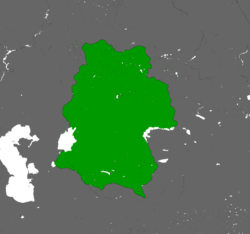Uzbek Khanate
Uzbek Khanate Abulkhairids | |||||||||||||
|---|---|---|---|---|---|---|---|---|---|---|---|---|---|
| 1428–1471 | |||||||||||||
 The Uzbek Khanate in 1448 | |||||||||||||
| Status | Confederate Khanate | ||||||||||||
| Capital |
| ||||||||||||
| Common languages |
| ||||||||||||
| Religion | |||||||||||||
| Government | Hereditary monarchy | ||||||||||||
| Khan | |||||||||||||
• 1428–1468 | Abu'l-Khayr Khan | ||||||||||||
• 1468–1471 | Sheikh Haidar | ||||||||||||
| Historical era | Early modern period | ||||||||||||
• Abu'l-Khayr becomes the Uzbek Khan | 1428 | ||||||||||||
• Abu'l-Khayr defeats Hajji Muhammad | 1428 | ||||||||||||
• Shaybanids invade Transoxiana | 1446 | ||||||||||||
• Janibeg and Kerei found the Kazakh Khanate[2] | 1466 | ||||||||||||
• Death of Abu'l-Khayr | 1468 | ||||||||||||
• Disestablished | 1471 | ||||||||||||
| |||||||||||||
The Uzbek Khanate (Turki/Kypchak: اوزبک خانلیغی[n 1]), also known as the Abulkhair Khanate[3] (Turki/Kypchak: ابو الخیر خانلیغی) was a Shaybanid state preceding the Khanate of Bukhara. During the few years it existed, the Uzbek Khanate was the preeminent state in Central Asia, ruling over most of modern-day Uzbekistan, much of Kazakhstan and Turkmenistan, and parts of southern Russia. This is the first state of the Abulkhairids, a branch of the Shaybanids.
Etymology
The dynasty of
History
Before Abu'l-Khayr Khan
Starting with
Abu'l-Khayr Khan

By the time of Abu'l-Khayr's birth in 1412, the
In 1430 or 1431, Abu'l-Khayr and his army marched south into
Abu'l-Khayr invaded the Golden Horde sometime after this and defeated Mustafa Khan near Astrakhan. The Uzbeks lost around 4,500 men during this campaign.
Prior to the death of
In 1451, Abu'l-Khayr allied with the Timurid
Kazakh Insurrection
Starting in the 1460s, the Kazakh khans warred for control of modern-day
Regarding these events, 16th century Khaidar Duglati in his Tarikh-i Rashidi reports:[5]
At that time, Abulkhair Khan exercised full power in Dasht-i-Kipchak. He had been at war with the Sultánis of Juji; while Jáni Beg Khán and Karáy Khán fled before him into Moghulistán. Isán Bughá Khán received them with great honor, and delivered over to them Kuzi Báshi, which is near Chu, on the western limit of Moghulistán, where they dwelt in peace and content. On the death of Abulkhair Khán the Ulus of the Uzbegs fell into confusion, and constant strife arose among them. Most of them joined the party of Karáy Khán and Jáni Beg Khán. They numbered about 200,000 persons, and received the name of Uzbeg-Kazák. The Kazák Sultáns began to reign in the year 870 [1465–1466] (but God knows best), and they continued to enjoy absolute power in the greater part of Uzbegistán, till the year 940 [1533–1534 A. D.].
Death of Abu'l-Khayr Khan and Successors
Somewhere around 1468–1470, Abu'l-Khayr Khan died in battle against the Kazakhs along with several of his sons. Sheikh Haidar, also known as Baruj Oghlan (Some sources have them as the same person or different persons), the eldest of Abu'l-Khayr's sons, succeeded him. Sheikh Haidar's reign was short and was ended after conflicts with a rival khan, Ibak.[4]
After Shaybani was helped by the
In 1500, Shaybani officially conceded all the Kazakh held lands in
Muhammad Shaybani was killed in the
Rulers
Khans of Shaybanid Domains
These are the khans ruling over the domains of the Uzbeks prior to the Abulkhairids.[6] [8]
- Shiban
- Bahadur Oghul
- Jochi Buqa
- Bad Oghul
- Mengu Timur Oghlan
- Fulad Oghul
- Ibrahim Sultan
- Dawlat Shaykh Oghlan
Abulkhairids
- Abu'l-Khayr Khan, son of Dawlat Shaykh Oghlan
- Sheikh Haidar, son of Abu'l-Khayr, died in battle in 1471 against Ibak Khan[7]
- Muhammad Shaybani, grandson of Abu'l-Khayr Khan
See also
Notes
- Kypchak language.
References
- ^ Sela, Ron (2022). "The "Sultans of the Turks"". In Tasar, Eren; Frank, Allen J; Eden, Jeff (eds.). From the Khan's Oven. Leiden & Boston: Brill. p. 95.
- ^ ISBN 978-0-8179-9353-5.
- ^ Gian Luca Bonora; Niccolò Pianciola; Paolo Sartori (2009). Kazakhstan: Religions and Society in the History of Central Eurasia. p. 24.
- ^ ISBN 978-92-3-103876-1.
- ^ Kenzheakhmet Nurlan (2013). The Qazaq Khanate as Documented in Ming Dynasty Sources. p. 140.
- ^ ISBN 978-0-253-35385-6.
- ^ a b c 霍渥斯 (1880). "9". History of the Mongols: From the 9th to the 19th Century ... 文殿閣書莊. pp. 686–700.
- ^ "Art | the Metropolitan Museum of Art". Archived from the original on 2019-03-30. Retrieved 2018-06-14.
- ^ "Archived copy". www.metmuseum.org. Archived from the original on 26 May 2016. Retrieved 15 January 2022.
{{cite web}}: CS1 maint: archived copy as title (link)
